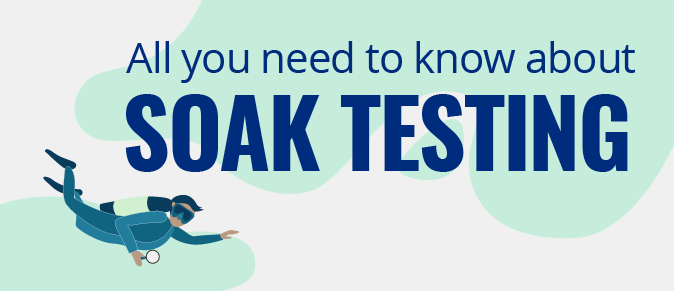What is Soak Testing?
Introduction
If you plan to achieve or look to maintain the maximum performance of your systems during operating hours, you may need a few performance tests verifying your system’s stability and load during the final phase of the development cycle. This kind of tests is called soak tests, which help you discover immediate performance-related problems—such as memory leaks or resources leaks—before the release of the product on a particular platform.
What is Soak Testing?
Soak testing (otherwise known as endurance testing, capacity testing, or longevity testing) involves testing the system to detect the performance-related issues such as stability and response time by requesting the designed load on a system. The system is then evaluated to see whether it could perform well under a significant load for an extended period, thereby measuring its reaction and analyzing its behavior under sustained use. Soak testing is a type of load testing.
There is a myriad of soak testing tools these days, such as LoadStorm, LoadRunner, LoadUI, OpenSTA, Apache JMeter, Appvance, and WebLoad.
Besides, there are some supporting tools that make sure your system works properly under normal conditions, such as Katalon Studio, Selenium, Robot framework.
Examples of Soak Testing
Ideally, a soak test should run as long as possible, though it will depend on the system for you to determine the duration of your test. Below are some examples when soak testings can be considered:
- When a bank announces that it will be closing, its system is expected to handle a large number of transactions during the closing days of the bank. This event is rare and unexpected, but your system has to handle this unlikely situation anyway.
- A system needs to withstand the period of no on-call staff. Usually, this will happen when the staff doesn’t work on the weekend, so the soak test would prove the system’s ability to function for a period longer than a weekends-worth of non-stop operation.

Your system is required to process 1000 transactions in 1 hour. You may need to test not only this capability but also go beyond this requirement: testing 1000 transactions in half an hour or 2000 in 1 hour.
Several Considerations for Soak Testing
- A soak test duration is often decided by the system’s availability.
- Every application must run without interruption.
- Each system normally has a frequent maintenance window time; such period will be the key factor in deciding the scope of a soak test.
Why Should You Perform a Soak Test?
Soak testing is mainly used to identify and optimize potential problems, such as memory leaks, resource leaks, or degradation that could happen over time, to avoid impaired performance or system errors. While stress tests will help the development team to test the system to its limits, soak testing takes the system to its limits over a sustained period of use. In other words, soak testing allows the team to mimic the real world usage, in which the users will constantly need access to the system.
Advantages that Soak Testing Brings
- It guarantees the application’s fitness.
- It detects bugs that could not be found by other performance tests.
- It spots the deterioration in performance, which could happen under high continuous load, and helps to fix those issues so that the application will be more robust.
- It shows how sustainably the system runs over time.
- The test result could be used to validate or improve customers’ infrastructure demands.
Challenges of Soak Testing?
- The test is a time-consuming process, and it would be inconvenient to be conducted on a project with very strict time constraints.
- You need to use an automation tool together with technical expertise since soak tests run over an extended period of time and consume a lot of data.
- It is often difficult to determine how much test is worth applying.
- If the test environment is not correctly detached from the live production environment, the errors found by the soak test could negatively impact the whole working system, causing data loss or data corruption permanently.
When to do Soak Testing?

Before a system is released on a particular platform to clients, it must successfully undergo a series of load tests at higher or similar traffic levels. Then you execute the soak test. Soak testing will help you to see how the system runs for a continuous availability period. If there are any issues like memory leaks or memory corruption during the test, it should be reported immediately.
Since the process could take time as long as a day, soak testing should be done over the weekends, although it also depends entirely on the test situation’s restrictions.
Soak testing is now one of the most vital requirements that any team must strictly comply with for a successful deployment.
Soak Testing Strategies
Before performing a soak test, you need to take a bird-eye view of the system and determine:
- Testing Environment:
Figure out which hardware, software, database, and operating system to perform the soak test.
- Test Scenarios:
Since soak testing is an extensive process, it is important to design, review, and finalize the test scenarios before performing any tests. Here, the development team also needs to determine how heavy the load that will be put on the system.
- Test Estimation:
The duration of the soak test is essential depending on the scope of the system. It also depends on the involvement of the development team and clients, actual production use, and more.
- Risk Analysis:
Consider some questions, such as: How the soak test remains consistent over use? Are there any bugs that have yet to be detected? Are there any external interferences that will cause the systems to go down?
What are the Common Issues that Soak Testing Detects?
- Memory allocation (memory leaks which finally lead to a memory crisis or rounding failures that only display over time).
- Database resource usage (errors when closing the database cursors under certain conditions that would eventually cause the entire system to come to a standstill).
- It can also bring about a deterioration in performance, that is, to make sure that the response time after an extended period is as good as it is when the test starts.
- Errors when closing connections between tiers of a multilayer system under certain circumstances that could block some or all of its modules.
- The gradual deterioration in the response time of some tasks as internal data-structures are less organized over an extended test period.
Before doing any soak testing, it is important to ensure that your system works properly under normal conditions. Katalon Studio provides a simple solution for the software testing system, helping the development cycle run smoothly and guaranteeing a successful deployment.

